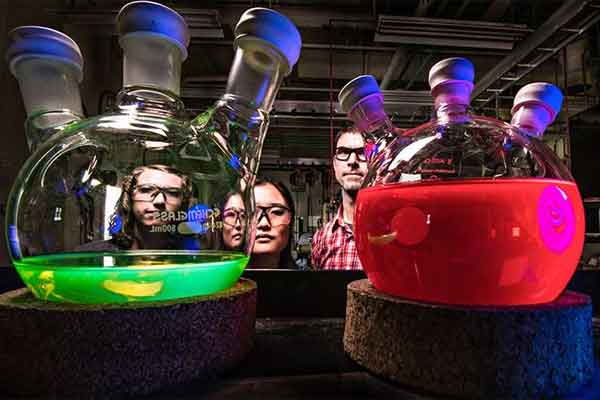Scientists with the Energy Department’s National Renewable Energy Laboratory (NREL) for the first time discovered how to make perovskite solar cells out of quantum dots and used the new material to convert sunlight to electricity with 10.77 percent efficiency.
The research, Quantum dot-induced phase stabilization of a-CsPbI3 perovskite for high-efficiency photovoltaics, appears in the journal Science. The authors are Abhishek Swarnkar, Ashley Marshall, Erin Sanehira, Boris Chernomordik, David Moore, Jeffrey Christians, and Joseph Luther from NREL. Tamoghna Chakrabarti from the Colorado School of Mines also is a co-author.
In addition to developing quantum dot perovskite solar cells, the researchers discovered a method to stabilize a crystal structure in an all-inorganic perovskite material at room temperature that was previously only favorable at high temperatures. The crystal phase of the inorganic material is more stable in quantum dots.
Most research into perovskites has centered on a hybrid organic-inorganic structure. Since research into perovskites for photovoltaics began in 2009, their efficiency of converting sunlight into electricity has climbed steadily and now shows greater than 22 percent power conversion efficiency. However, the organic component hasn’t been durable enough for the long-term use of perovskites as a solar cell.

Ashley Marshall, Erin Sanehira and Joey Luther with solutions of all-inorganic perovskite quantum dots, showing intense photoluminescence when illuminated with UV light. Credit: NREL
NREL scientists turned to quantum dots-which are essentially nanocrystals-of cesium lead iodide (CsPbI3) to remove the unstable organic component and open the door to high-efficiency quantum dot optoelectronics that can be used in LED lights and photovoltaics.
The nanocrystals of CsPbI3 were synthesized through the addition of a Cs-oleate solution to a flask containing PbI2 precursor. The NREL researchers purified the nanocrystals using methyl acetate as an anti-solvent that removed excess unreacted precursors. This step turned out to be critical to increasing their stability.
Contrary to the bulk version of CsPbI3, the nanocrystals were found to be stable not only at temperatures exceeding 600 degrees Fahrenheit but also at room temperatures and at hundreds of degrees below zero. The bulk version of this material is unstable at room temperature, where photovoltaics normally operate and convert very quickly to an undesired crystal structure.
NREL scientists were able to transform the nanocrystals into a thin film by repeatedly dipping them into a methyl acetate solution, yielding a thickness between 100 and 400 nanometers. Used in a solar cell, the CsPbI3 nanocrystal film proved efficient at converting 10.77 percent of sunlight into electricity at an extraordinary high open circuit voltage. The efficiency is similar to record quantum dot solar cells of other materials and surpasses other reported all-inorganic perovskite solar cells.
The research was funded in part by the Energy Department’s Office of Science and by the SunShot Initiative.
NREL is the U.S. Department of Energy’s primary national laboratory for renewable energy and energy efficiency research and development. NREL is operated for the Energy Department by The Alliance for Sustainable Energy, LLC.
The SunShot Initiative is a collaborative national effort that aggressively drives innovation to make solar energy fully cost-competitive with traditional energy sources before the end of the decade. Through SunShot, the Energy Department supports efforts by private companies, universities, and national laboratories to drive down the cost of solar electricity to $0.06 per kilowatt-hour.












Comments